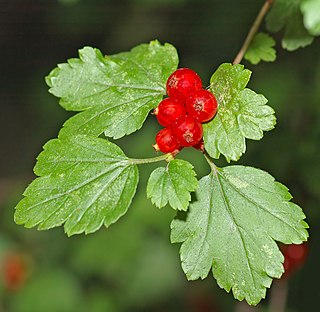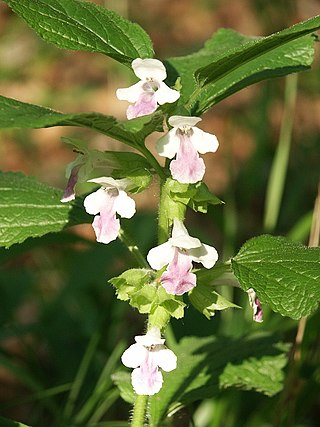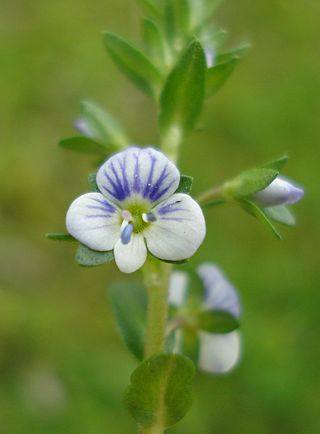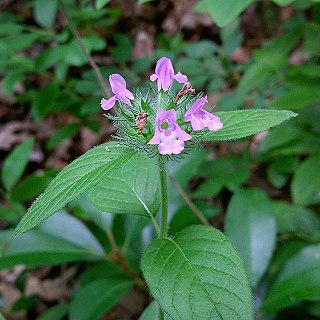
Satureja is a genus of aromatic plants of the family Lamiaceae, related to rosemary and thyme. It is native to North Africa, southern and southeastern Europe, the Middle East, and Central Asia. A few New World species were formerly included in Satureja, but they have all been moved to other genera. Several species are cultivated as culinary herbs called savory, and they have become established in the wild in a few places.

A subshrub or undershrub is either a small shrub or a perennial that is largely herbaceous but slightly woody at the base. The term is often interchangeable with "bush".

Epimedium, also known as barrenwort, bishop's hat, fairy wings, horny goat weed, or yin yang huo, is a genus of flowering plants in the family Berberidaceae. The majority of the species are endemic to China, with smaller numbers elsewhere in Asia, and a few in the Mediterranean region.

Lilium bulbiferum, common names orange lily, fire lily,Jimmy's Bane,tiger lily and St. John's Lily, is a herbaceous European lily with underground bulbs, belonging to the Liliaceae.

Elodea canadensis is a perennial aquatic plant, or submergent macrophyte, native to most of North America. It has been introduced widely to regions outside its native range and was first recorded from the British Isles in about 1836.

Eryngium alpinum, the alpine sea holly, alpine eryngo or queen of the Alps, is a herbaceous perennial plant in the family Apiaceae.

Ribes alpinum, known as mountain currant or alpine currant, is a small deciduous, dioecious shrub native to central and northern Europe from Finland and Norway south to the Alps and Pyrenees and Caucasus, Georgia; in the south of its range, it is confined to high altitudes. It is scarce in western Europe, in Britain being confined to a small number of sites in northern England and Wales.

Ballota nigra, black horehound, is a perennial herb of the family Lamiaceae. It is native to the Mediterranean region and to central Asia and it can be found throughout Europe. It is also naturalized in Argentina, New Zealand, and the Eastern United States. It blooms in the Northern Hemisphere from May to August.

Vinca major, with the common names bigleaf periwinkle, large periwinkle, greater periwinkle and blue periwinkle, is a species of flowering plant in the family Apocynaceae, native to the western Mediterranean. Growing to 25 cm (10 in) tall and spreading indefinitely, it is an evergreen perennial, frequently used in cultivation as groundcover.

Melittis melissophyllum is a species of flowering plant in the mint family, Lamiaceae. Its common name is bastard balm. It is the only species in the monotypic genus Melittis. The genus name is derived from the Greek melitta, which is in turn from melissa.

Veronica serpyllifolia, the thyme-leaved speedwell or thymeleaf speedwell, is a perennial flowering plant in the plantain family. The species as a whole is native mostly to Eurasia & North America, and has three variants with their individual ranges; var. serpyllifolia has particularly spread beyond its native range.

Achillea erba-rotta, common name simple leaved milfoil, is a perennial flowering plant of the genus Achillea, belonging to the sunflower family.

Clinopodium vulgare, the wild basil, is a species of flowering plant in the family Lamiaceae.
Iris benacensis is a plant species in the genus Iris, it is also in the subgenus Iris. It is a rhizomatous perennial, from Italy. It has similar sized leaves and stem, and blue-purple shaded flowers, that have a white, blue and yellow beard. It was once classified as a synonym of Iris aphylla, before being re-classified as a species in its own right, although some sources still call it a synonym. It is cultivated as an ornamental plant in temperate regions.
Iris bicapitata is a plant species in the genus Iris, it is also in the subgenus Iris. It is a rhizomatous perennial, from the Gargano Peninsula, Italy. It has sickle or pointed leaves, shorter than the flowering stem. It has two flowers, which come in variable shades from yellow, white, lilac, blue and violet. They can also be bi-coloured. It is thought to have been derived from Iris pseudopumila. It is cultivated as an ornamental plant in temperate regions.

Iris pallida subsp. cengialti is a subspecies in the genus Iris, it is also in the subgenus Iris. It is a rhizomatous perennial, from Italy and Slovenia. It has yellowish-green, glaucous, lanceolate or ensiform leaves, tall stem, green flushed with purple spathes, 2 short branches, 2–3 scented flowers, in shades of violet, blue-violet, deep purple, blue-purple, deep blue-purple, pale purple, deep blue, to mid-blue. It has a yellow or orange tipped beard. It was originally published as Iris cengialti but then re-classified as a subspecies of Iris pallida, and known as Iris pallida subsp. cengialti, but it is often still called Iris cengialti. It is cultivated as an ornamental garden plant in temperate regions.

Linum alpinum is a species of perennial plant belonging to the Linaceae family.

Petrorhagia saxifraga, known as tunic flower or coat flower, is a small, herbaceous flowering plant in the family Caryophyllaceae. It is native to parts of Europe and introduced to the United States and Canada, Great Britain, and Sweden. Petrorhagia saxifraga is also known as tunic saxifrage, pink saxifrage, or just pink.

Hypericum coris, the heath-leaved St. John's wort, also called yellow coris, is a species of flowering plant in the family Hypericaceae, and is the type species of sect. Coridium. It is a low shrub, and it is found in Switzerland and northwestern Italy. The species has been a popular garden plant since the 18th century, valued for its long flowering period and for how well it adapts to cultivation.

Clinopodium menthifolium, commonly known as the wood calamint or woodland calamint, is a species of flowering plant in the mint family, Lamiaceae. It is found throughout southern and central Europe from the United Kingdom and east as far as temperate parts of Asia, and as south as North Africa. It grows up to 1,700 m (5,600 ft) in elevation.





















